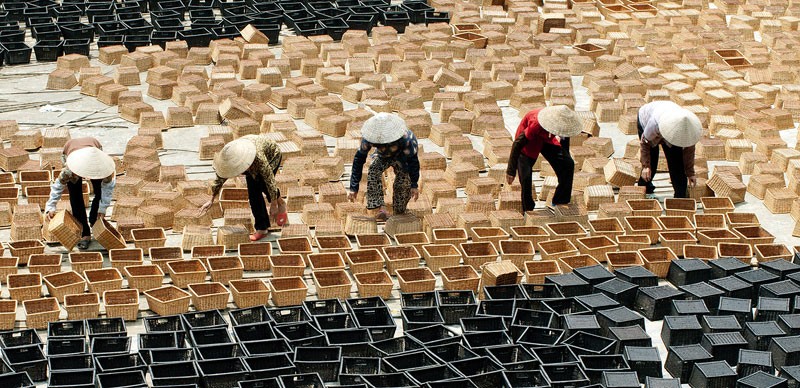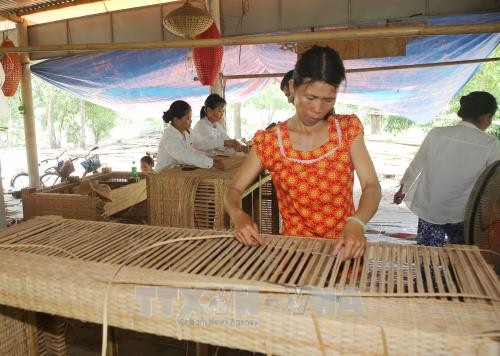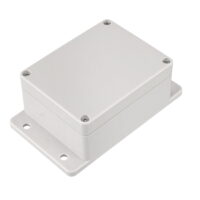Uncategorized
Vietnam’s Bamboo and Rattan Industry: Great Growth Potential Ahead
Currently, Vietnam has over 1,000 bamboo and rattan craft villages, accounting for about 24% of all traditional craft villages nationwide. The northern and central regions are known for producing bamboo, rattan, palm leaf, and sedge products, while the southwestern region focuses more on items made from water hyacinth and wild palm leaves. Some well-known bamboo and rattan craft villages include Phu Vinh, Tang Tien, Ninh So, Thach Cau, Ngoc Dong, and Bao La village in Quang Phu commune, Quang Dien district, Thua Thien Hue province.
Currently, there are over 1,000 bamboo and rattan craft villages across Vietnam, accounting for 24% of the country’s total number of traditional craft villages. In Hanoi alone, there are 365 bamboo and rattan craft villages and communities, with nearly 33,000 households and around 200 businesses and cooperatives involved in the trade. These activities provide jobs for more than 100,000 workers, with an average annual income of 35 to 40 million VND per person. The northern and central regions mainly focus on bamboo, rattan, palm leaf, and sedge products, while the southwestern region specializes in items made from water hyacinth and wild palm leaves.
Some of the most renowned bamboo and rattan craft villages in Vietnam include Phu Vinh Village, located in Phu Nghia Commune, Chuong My District, Hanoi. This village is famous for its handmade household items such as baskets, trays, plates, tables, and chairs. Tang Tien Village in Tang Tien Commune, Viet Yen District, Bac Giang Province, boasts over 300 years of history and is known for high-quality products like mats, pillows, handbags, and blinds. These items are carefully preserved by local artisans and are resistant to termites and fading. Ninh So Village, in Ninh So Commune, Thuong Tin District, Hanoi, is considered one of the earliest bamboo and rattan craft villages in the city. It is known for producing traditional farming tools such as fish traps and baskets used by Vietnamese farmers. Thach Cau Village, located in Nam Truc District, Nam Dinh Province, has a long-standing tradition with artisans ranging in age from 12 to over 70. Their skilled hands produce essential rural items like baskets, sieves, and winnowing trays. Ngoc Dong Village in Hoang Dong Commune, Duy Tien District, Ha Nam Province, also stands out. Unlike other villages that use bamboo and cane, Ngoc Dong’s products are crafted mainly from rattan and giang (a type of climbing bamboo), resulting in a diverse range of items such as rattan chairs, trays, vases, plates, and bowls. Lastly, Bao La Village in Quang Phu Commune, Quang Dien District, Thua Thien Hue Province, is well-known for producing Vietnam’s most durable and high-quality winnowing baskets (called thúng). For generations, Bao La has specialized in making traditional tools from bamboo and cane, including thúng, nia, gian, and sàng, essential items in rural life.

Phu Vinh Bamboo and Rattan Craft Village, Phu Nghia Commune, Chuong My District, Hanoi
Promising Results in Bamboo and Rattan Exports
Currently, bamboo, rattan, sedge, and other woven products are consumed both domestically and internationally, but export is receiving greater focus from businesses.
The domestic market has experienced rapid growth over the past 6 to 10 years, with an increase of more than 15%, primarily serving the home furniture, hotel, and resort sectors. In addition, international tourists have also become a key customer group that businesses are increasingly targeting.
The domestic market holds great potential for bamboo, rattan, and sedge products; however, in reality, their market share remains modest. One reason is that most businesses in the industry primarily focus on producing for export. In addition, the domestic distribution system is still limited, fragmented, and lacks professionalism, making it difficult to meet the full value chain requirements.
In terms of exports:
Among Vietnam’s exported bamboo, rattan, sedge, and other woven products, those made with braided materials (such as plastic ropes, wild palm leaves, and guot fibers) accounted for the highest share—25.5% of total export turnover in the first 11 months of 2018, reaching USD 57.50 million, up 44.1% compared to the same period in 2017. Following that were water hyacinth products, with an export value of USD 50.68 million, up 14.8% year-over-year. Braided sedge products reached USD 48.63 million, a 28.6% increase over the same period in 2017. Meanwhile, woven bamboo products brought in USD 23.55 million, down 7.9% compared to the previous year.
In previous years, woven bamboo products were the most exported items, but since 2017, their export volume has declined. In the first 11 months of 2018, exports of woven bamboo products reached USD 44.98 million, down 5.1% compared to the same period in 2017.

Rattan Chair Production for Export in Thuy Lap Village, Quang Loi Commune, Quang Dien District (Thua Thien–Hue Province)
The EU and the U.S. are the two main export markets for Vietnam’s bamboo, rattan, sedge, and other woven products. Exports to these two markets alone account for nearly 70% of the country’s total export turnover in this product category.
In the first 11 months of 2018, exports of bamboo, rattan, sedge, and other woven products to both the EU and U.S. markets increased. Exports to the U.S. grew significantly, reaching USD 61 million, up 26.7% compared to the same period in 2017. This raised the share of exports to the U.S. from 24.7% in the first 11 months of 2017 to 27.1% during the same period in 2018. Water hyacinth products were the most exported items to the U.S. market, reaching USD 23.42 million, up 38.3% year-over-year. These were followed by products made from plastic cords, wild palm leaves, guot fibers, as well as braided sedge and bamboo.
In the first 11 months of 2018, exports of bamboo, rattan, sedge, and other woven products to the EU market reached USD 94.62 million, up 6.2% compared to the same period in 2017. Among EU countries, Germany, France, the United Kingdom, the Netherlands, and Spain were the largest importers of these Vietnamese products. Braided sedge was the most exported item to the EU, reaching USD 27.22 million—an increase of 32.9% over the same period in 2017. This was followed by products made from plastic cords, wild palm leaves, guot fibers, as well as woven bamboo and water hyacinth products.
In addition to the two main markets mentioned above, Vietnam’s bamboo, rattan, sedge, and other woven products are also widely exported to Japan, Australia, South Korea, China, Canada, and other countries.
Challenges Facing Vietnam’s Bamboo and Rattan Industry
Although Vietnam’s exports of bamboo, rattan, sedge, and other woven products have achieved positive results in recent years, the overall export sector still faces many challenges. As Vietnam continues to deepen its integration into the global economy, domestic enterprises—particularly those in the bamboo and rattan industry—are confronted with significant obstacles due to limited experience in many areas and underdeveloped production infrastructure. In reality, bamboo and rattan products are handmade items that require careful preservation, yet many facilities lack proper conditions. Poor infrastructure means that even a rainstorm can lead to mold, affecting product quality, while foreign producers often have far superior production environments. Due to limited capital, Vietnamese bamboo and rattan enterprises are often unable to invest in specialized facilities. In addition, the lack of production space means that workshops are typically set up in makeshift or repurposed areas rather than organized manufacturing systems. Most facilities also struggle with limited production space, storage for raw materials, and showrooms for selling their products.
In addition, Vietnamese bamboo and rattan enterprises face many difficulties in trade promotion. In international markets, the survival of businesses in this industry depends heavily on offering products with fresh and attractive designs. However, innovation and product development in Vietnam have not yet met market demands. Currently, most Vietnamese companies produce according to foreign designs, and those that have managed to stay in the industry primarily operate as subcontractors for international corporations—leaving them vulnerable to price pressure. Moreover, many businesses and craft villages still rely on exporting through domestic intermediaries. As a result, profit margins in bamboo and rattan production remain low, and worker incomes are modest.
The lack of control over raw material sources is also a pressing issue. In the past, sourcing materials was relatively easy, but in recent years, this has become increasingly difficult as forests that once supplied raw materials in areas like Dong Nai and Binh Thuan have been cleared for farming. The rising cost of raw materials, high transportation expenses, and inconsistent supply have significantly impacted production costs, product pricing, and overall competitiveness.
Limited market access is another major challenge. While we are accustomed to the approach of producing quickly, in large quantities, with good quality and low cost, the question of how to sell quickly and in high volumes remains a new and difficult issue. The domestic market system is still unstable; many producers do not know who to sell their products to, leading to stockpiles and slow circulation. In rural areas, people have limited access to new products and modern consumer knowledge. Participating in international trade fairs is costly, and most businesses lack the experience needed to research foreign markets. They also face difficulties in understanding international trade conventions, market demands, methods of approaching foreign partners, negotiation techniques, and securing binding agreements for timely payment. Domestic enterprises are not yet unified as a strong bloc when dealing with international partners. Relationships remain fragmented and individualistic, which weakens their competitiveness on the global stage.
Boost Export Activities
Products in the bamboo and rattan industry are primarily intended for export; therefore, in order to increase export turnover, businesses and production facilities must research and understand target markets to meet customer demand. Companies need to continuously innovate in design, diversify their product offerings, and develop appropriate market entry strategies. Regardless of the chosen entry method, it is essential to consider key factors such as market size, consumer preferences, distribution channels, competition, and pricing. The following factors should be taken into account:
– Understand consumer preferences.
– Reduce product costs.
– Ensure timely delivery.
– Maintain consistent product quality.
The market is highly diverse, with a wide range of customer segments, making it essential to research and identify the unique characteristics and consumer preferences of each region, country, or locality in order to develop products that meet specific demands. This is not easy to recognize and requires businesses to be proactive in all aspects of their operations.
Enterprises must be proactive and prepared to address trade barriers while maximizing their internal strengths. The quality of bamboo and rattan products is evaluated based on criteria such as durability, aesthetics, environmental friendliness, cultural and artistic value, and design appeal. Attention must also be paid to product design, as markets like Japan and Europe place high importance on items that blend modern style with both Asian and European traditions. More demanding customers even expect products to reflect the personal touch or signature style of the creator.
In addition, businesses need to build strong branding for their products. This is essential for gaining a solid foothold in markets such as Japan and the United States. When products are registered under the “Made in Vietnam” label, it not only enhances their market position but also serves as an effective way to promote Vietnamese goods internationally. Regardless of business size, branding must be seen as a matter of survival. A brand is an invaluable asset, and the value it brings goes beyond the business or manufacturing facility—it also directly impacts workers. When a product carries a recognized brand, workers are more likely to receive fair and higher compensation that reflects the true value of their craftsmanship.
 115 x 90 x 55mm Electronic ABS Plastic DIY Junction Box Enclosure Case Grey
115 x 90 x 55mm Electronic ABS Plastic DIY Junction Box Enclosure Case Grey  John Deere Original Equipment Extension Spring #M151783
John Deere Original Equipment Extension Spring #M151783